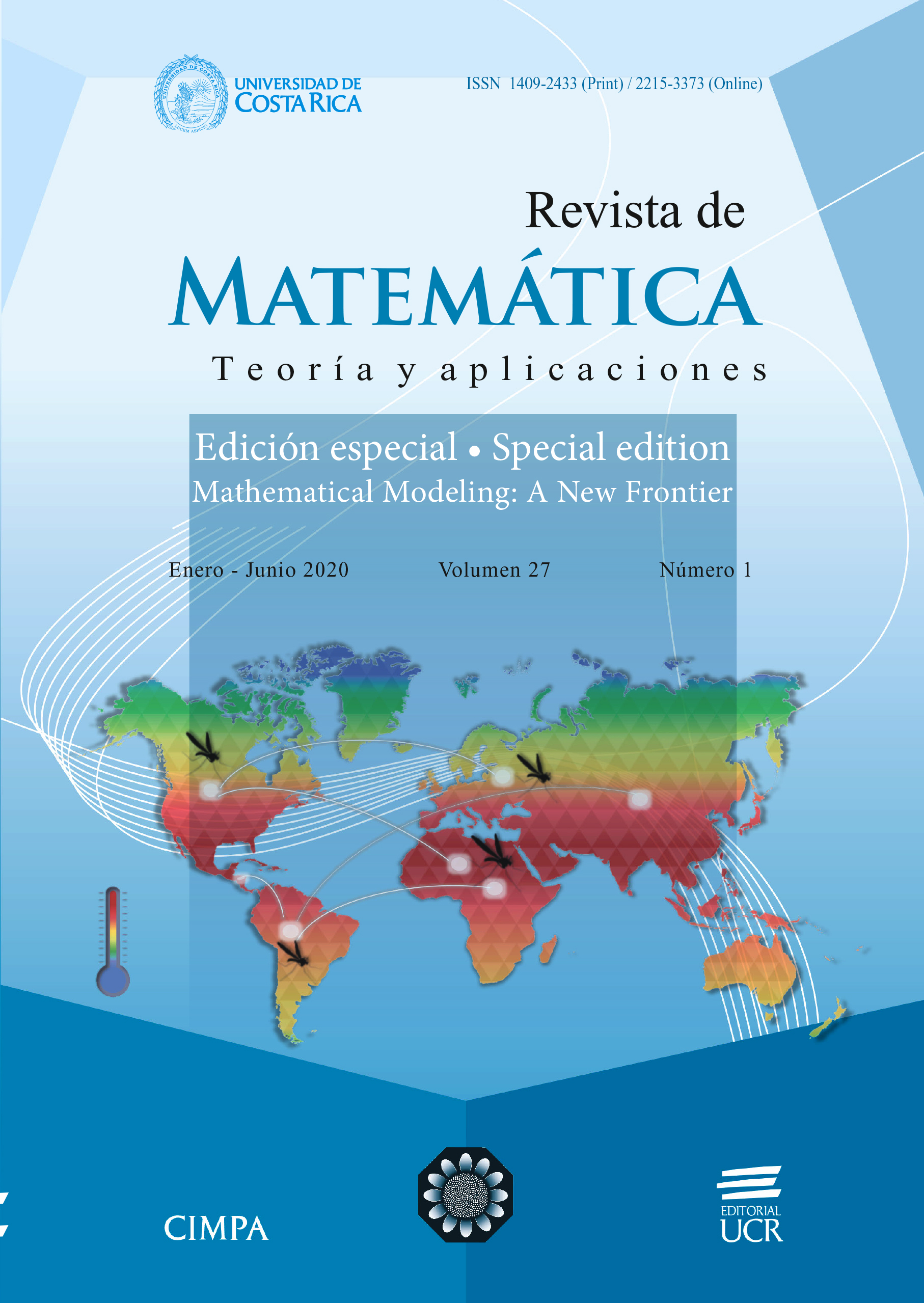Abstract
Bacterial infections elicit immune responses including neutrophils, whose recruitment is stimulated by the bacteria’s presence but which die after eliminating those bacteria. This dual interaction between bacteria and neutrophil concentrations, more complicated than the simple predator-prey relationship that describes macrophage-bacteria interactions, creates an environment in which neutrophils may only be able to clear sufficiently small infections. This study describes this relationship using a simple nonlinear dynamical system which exhibits bistability behavior known as a backward bifurcation. Bacterial growth is assumed limited by a key nutrient. In contrast to a previous study which held neutrophil and nutrient levels constant and required saturation terms to produce bistability, our model shows that simple bilinear terms support bistability when nutrient and neutrophil densities are allowed to vary in response to bacterial density. An example application involving Borrelia burgdorferi, which feeds on manganese, illustrates why neutrophils’ rapid response is key to their ability to contain bacterial infections.
References
R. Antia, J.C. Koella, A model of non-specific immunity, Journal of Theoretical Biology 168(1994), no. 2, 141–150. doi: 10.1006/jtbi.1994.1094
M.G. Baker, C.D. Simpson, B. Stover, L. Sheppard, H. Checkoway, B.A. Racette, N.S. Seixas, Blood manganese as an exposure biomarker: state of the evidence, Journal of Occupational and Environmental Hygiene 11(2014), no. 4, 210–217. doi: 10.1080/15459624.2013.852280
V. Bane, M. Lehane, M. Dikshit, A. O’Riordan, A. Furey, Tetrodotoxin: chemistry, toxicity, source, distribution and detection, Toxins 6(2014), no. 2, 693–755. doi: 10.3390/toxins6020693
A. Carter, A. Toja, O. Olawoyin, J. Gonzalez, J. Grover, H. Kojouharov, C.Kribs Zaleta, A theoretical model of coinfection dynamics: modeling competition dynamics between Borrelia burgdorferi and Anaplasma phagocytophilum within a human host, Mathematics Department, Preprint Series 2014-06, University of Texas at Arlington, 2014.
V.G. Daniels, P.R. Wheater, H.G. Burkitt, Functional histology: A text and colour atlas, Churchill Livingstone, Edinburgh, 1979.
A.N. Datar, N. Kaur, S. Patel, D.F. Luecke, E. Sapi, In vitro effectiveness of samento and banderol herbal extracts on the different morphological forms of Borrelia burgdorferi, Ph.D. Thesis, Univ. of New Haven, West Haven CT, 2010.
H. Drakesmith, A.M. Prentice, Hepcidin and the iron-infection axis, Science 338(2012), no. 6108, 768–772. doi: 10.1126/science.1224577
L. Geggel, How much blood is in the human body, LiveScience, 2016. Available at https://www.livescience.com/32213-how-much-blood-is-in-the-human-body.html
R.B. Jain, Y.S. Choi, Normal reference ranges for and variability in the levels of blood manganese and selenium by gender, age, and race/ethnicity for general U.S. population, Journal of Trace Elements in Medicine and Biology 30(2015), 142–152. doi: 10.1016/j.jtemb.2014.12.004
Y. Li, A. Karlin, J.D. Loike, S.C. Silverstein, A critical concentration of neutrophils is required for effective bacterial killing in suspension, Proceedings of the National Academy of Sciences of the United States of America 99(2002), no. 12, 8289–8294. doi: 10.1073/pnas.122244799
R. Malka, V. Rom-Kedar, Bacteria-phagocyte dynamics, axiomatic modelling and mass-action kinetics, Mathematical Biosciences and Engineering 8(2011), no. 2, 475–502. doi: 10.3934/mbe.2011.8.475
R. Malka, E. Shochat, V. Rom-Kedar, Bistability and bacterial infections, PLoS ONE 5(2010), no. 5, 1–10. doi: 10.1371/journal.pone.0010010
R. Malka, B. Wolach, R. Gavrieli, E. Shochat, V. Rom-Kedar, Evidence for bistable bacteria-neutrophil interaction and its clinical implications, Journal of Clinical Investigation 122(2012), no. 8, 3002–3011. doi: 10.1172/JCI59832
H. Mayer, K. S. Zaenker, U. an der Heiden, A basic mathematical model of the immune response, Chaos: An Interdisciplinary Journal of Nonlinear Science 5(1995), no. 1, 155–161. doi: 10.1063/1.166098
M.J. Niemiec, B. De Samber, J. Garrevoet, E. Vergucht, B. Vekemans, R. De Rycke, E. Björn, L. Sandblad, G. Wellenreuther, G. Falkenberg, P. Cloetens, L. Vincze, C.F. Urban, Trace element landscape of resting and activated human neutrophils on sub-micrometer level, Metallomics 7(2015), no. 6, 996–1010. doi: 10.1039/c4mt00346b
G. Petschenka, A. A. Agrawal, Milkweed butterfly resistance to plant toxins is linked to sequestration, not coping with a toxic diet, Proceedings of the Royal Society B 282(2015), no. 1818: 20151865, 1–9. doi: 10.1098/ rspb.2015.1865
S.S. Pilyugin, R. Antia, Modeling immune responses with handling time, Bulletin of Mathematical Biology 62(2000), no. 5, 869–890. doi: 10.1006/bulm.2000.0181
J.E. Posey, F.C. Gherardini, Lack of a role for iron in the Lyme disease pathogen, Science 288(2000), no. 5471, 1651–1653. doi: 10.1126/science.288.5471.1651
A.B. Santamaria, Manganese exposure, essentiality & toxicity, Indian Journal of Medical Research 128(2008), no. 4, 484–500.
S.C. Silverstein, R. Rabadan, How many neutrophils are enough (redux, redux)?, Journal of Clinical Investigation 122(2012), no. 8, 2776–2779. doi: 10.1172/JCI63939
A M. Smith, J.A. McCullers, F.R. Adler, Mathematical model of a threestage innate immune response to a pneumococcal lung infection, Journal of Theoretical Biology 276(2011), no. 1, 106–116. doi: 10.1016/j. jtbi.2011.01.052
T. Tak, K. Tesselaar, J. Pillay, J.A. Borghans, L. Koenderman, What’s your age again? Determination of human neutrophil half-lives revisited, Journal of Leukocyte Biology 94(2013), no. 4, 595–601. doi: 10.1189/jlb.1112571
B. Troxell, M. Ye, Y. Yang, S.E. Carrasco, Y. Lou, X. F. Yang, Manganese and zinc regulate virulence determinants in Borrelia burgdorferi, Infection and Immunity 81(2013), no. 8, 2743–2752. doi: 10.1128/IAI.00507-13
J.R. Zhang, S.J. Norris, Kinetics and in vivo induction of genetic variation of vlsE in Borrelia burgdorferi, Infection and Immunity 66(1998), no. 8, 3689–3697

